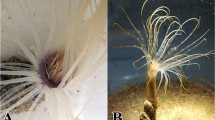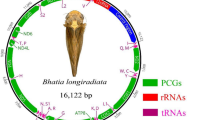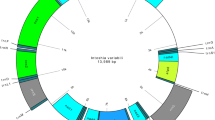Abstract
Mitochondrial genomes have recently become widely used in animal phylogeny, mainly to infer the relationships between vertebrates and other bilaterians. However, only 11 of 723 complete mitochondrial genomes available in the public databases are of early metazoans, including cnidarians (Anthozoa, mainly Scleractinia) and sponges. Although some cnidarians (Medusozoa) are known to possess atypical linear mitochondrial DNA, the anthozoan mitochondrial genome is circular and its organization is similar to that of other metazoans. Because the phylogenetic relationships among Anthozoa as well as their relation to other early metazoans still need to be clarified, we tested whether sequencing the complete mitochondrial genome of Savalia savaglia, an anthozoan belonging to the order Zoantharia (=Zoanthidea), could be useful to infer such relationships. Compared to other anthozoans, S. savaglia’s genome is unusually long (20,766 bp) due to the presence of several noncoding intergenic regions (3691 bp). The genome contains all 13 protein coding genes commonly found in metazoans, but like other Anthozoa it lacks most of the tRNAs. Phylogenetic analyses of S. savaglia mitochondrial sequences show Zoantharia branching closely to other Hexacorallia, either as a sister group to Actiniaria or as a sister group to Actiniaria and Scleractinia. The close relationships suggested between Zoantharia and Actiniaria are reinforced by strong similarities in their gene order and the presence of similar introns in the COI and ND5 genes. Our study suggests that mitochondrial genomes can be a source of potentially valuable information on the phylogeny of Hexacorallia and may provide new insights into the evolution of early metazoans.



Similar content being viewed by others
References
Addis JS, Peterson KJ (2005) Phylogenetic relationships of freshwater sponges (Porifera, Spongillina) inferred from analyses of 18S rDNA, COI mitochondrialDNA, and ITS2 rDNA sequences. Zool Scr 34:549–557
Beagley CT, Macfarlane JL, Pont-Kingdon GA, Okimoto R, Okada NA, Wolstenholme DR (1995) Mitochondrial genomes of Anthozoa (Cnidaria), In: Palmieri F, Papa S, Saccone C, Gadaleta N (eds) Progress in Cell Research Symposium on Thirty Years of Progress in Mitochondrial Bioenergetics and Molecular Biology. Elsevier Science BV, Amsterdam, pp 149–153
Beagley CT, Okada NA, Wolstenholme DR (1996) Two mitochondrial group I introns in a metazoan, thesea anemone Metridium senile: one intron contains genes for subunits 1 and 3 of NADH dehydrogenase. Proc Natl Acad Sci USA 93:5619–5623
Beagley CT, Okimoto R, Wolstenholme DR (1998) The mitochondrial genome of the sea anemone Metridium senile (Cnidaria): introns, a paucity of tRNA genes, and a near standard genetic code. Genetics 148:1091–1108
Beaton MJ, Roger AJ, Cavalier-Smith T (1998) Sequence analysis of the mitochondrial genome of Sarcophyton glaucum: conserved gene order among octocorals. J Mol Evol 47:697–708
Borchiellini C, Chombard C, Manuel M, Alivon E, Vacelet J, Boury-Esnault N (2004) Molecular phylogeny of Demospongiae: implications for classification and scenarios of character evolution. Mol Phylogenet Evol 32:823–837
Boore JL (1999) Animal mitochondrial genomes. Nucleic Acids Res 27:1767–1780
Bridge D, Cunningham CW, Schierwater B, Desalle R, Buss LW (1992) Class level relationships in the phylum Cnidaria: evidence from mitochondrial genome structure. Proc Natl Acad Sci USA 89:8750–8753
Collins AG (2002) Phylogeny of Medusozoa and the evolution of cnidarian life cycles. J Evol Biol 15:418–432
Dreyer H, Steiner G (2004) The complete sequence and gene organization of the mitochondrial genome of the gadilid scaphopod Siphonondentalium lobgtum (Mollusca). Mol Phyl Evol 31:605–617
Folmer O, Black M, Hoeh W, Lutz R, Vrijenhoek R (1994) DNA primers for amplification of mitochondrial cytochrome c oxidase subunit I from diverse metazoan invertebrates. Mol Mar Biol Biotechnol 3:294–299
Fukami H, Omori M, Hatta M (2000) Phylogenetic relationships in the coral family Acroporidae, reassessed by inference from mitochondrial genes. Zool Sci 17:689–696
Fukami H, Budd AF, Paulay G, Sole-Cava A, Chen CA, Iwao K, Knowlton N (2004) Conventional taxonomy obscures deep divergence between Pacific and Atlantic corals. Nature 427:832–835
Fukami H, Chen CA, Knowlton N (2005) Group I intron encoding the predicted homing endonuclease of the mitochondrial coxl gene of the scleractinian corals: horizontal transfer from a fungi donor. (submitted for publication)
Fukami H, Knowlton N (2005) Analysis of complete mitochondrial DNA sequences of three members of the Montastraea annularis coral species complex (Cnidaria, Anthozoa, Scleractinia). Coral Reefs Online
Guindon S, Gascuel O (2003) A simple, fast, and accurate algorithm to estimate large phylogenies by maximum likelihood. Syst Biol 52:696–704
Hall TA (1999) BioEdit: a user-friendly biological sequence alignement editor and analysis program for Windows 95/98/NT, Nucleic Acids Symp Ser 41:95–98
Herbert PD, Penton EH, Burns JM, Janzen DH, Hallwachs W (2004) Ten species in one: DNA barcoding reveals cryptic species in the neotropical skipper butterfly Astraptes fulgerator. Proc Natl Acad Sci USA 101:14812–14817
Huelsenbeck JP, Ronquist F (2001) MrBayes: a program for the Bayesian inference of phylogeny. Available at: http://morphbank.ebc.uu.se/mrBayes3/manual.php
Jennings RM, Halanych KM (2005) Mitochondrial genomes of Clymenella torquata (Maldanidae) and Rtftia pachyptila (Siboglinidae): evidence for conserved gene order in Annelida. Mol Biol Evol 22:210–222
Lavrov DV, Lang BF (2005) Transfer RNA gene recruitment in mitochondrial DNA. Trends Genet 21:129–133
Lavrov DV, Boore JL, Brown WM (2002) Complete mitochondrial DNA sequences of two millipedes suggest a new model for mitochondrial gene rearrangements: duplication and non-random loss. Mol Biol Evol 19:163–169
Lavrov DV, Forget L, Kelly M, Lang BF (2005) Mitochondrial genomes of two demosponges provide insights into an early stage of animal evolution. Mol Biol Evol 22:1231–1239
Lowe TM, Eddy SR (1997) tRNAscan-SE: a program for improved detection of transfer RNA genes in genomic sequence. Nucleic Acids Res 25:955–964
Löytynoja A, Milinkovitch MC (2001) SOAP, cleaning multiple alignments from unstable blocks. Bioinformatics 17:573–574
Mabuchi K, Miya M, Satoh TP, Westneat MW, Nishida M (2004) Gene rearrangements and evolution of tRNA pseudogenes in the mitochondrial genome of the parrotfish (Teleostei: Perciformes: Scaridae). J Mol Evol 59:287–297
Medina M, Collins AG, Silberman JD, Sogin ML (2001) Evaluating hypotheses of basal animal phylogeny using complete sequences of large and small subunit rRNA. Proc Natl Acad Sci USA 98:9707–9712
Mueller RL, Macey JR, Jaekel M, Wake DB, Boore JL (2004) Morphological homoplasy, life history evolution, and historical biogeography of plethodontid salamanders inferred from complete mitochondrial genomes. Proc Natl Acad Sci USA 101:13820–13825
Nichols SA, Barnes PAG (2005) A molecular phylogeny and historical biogeography of the marine sponge genus Placospongia (phylum Porifera) indicate low dispersal capabilities and widespread crypsis. J Exp Mar Biol Ecol 323:1–15
Palumbi SR, Martin A, Romano S, McMillan WO, Stice L, Grabowski G (1996) The simple fool’s guide to PCR. Kewalo Marine Laboratory and University of Hawaii, Honolulu
Rokas A, King N, Finnerty J, Carroll SB (2003) Conflicting phylogenetic signals at the base of the metazoan tree. Evol Dev 5:346–359
Rokas A, Krüger D, Caroll SB (2005) Animal evolution and the molecular signature of radiation compressed in time. Sciences 310:1933–1938
Romano S, Palumbi SR (1997) Molecular evolution of a portion of the mitochondrial 16S ribosomal gene region in scleractinian corals. J Mol Evol 45:397–411
Ronquist F, Huelsenbeck JP (2003) MrBayes 3: Bayesian phylogenetic inference under mixed models. Bioinformatics 19:1572–1574
Sanchez JA, McFadden CS, France SC, Lasker HR (2003) Molecular analyses of shallow-water Carribean octocorals. Mar Biol 142:975–987
Sano N, Kurabayashi A, Fujii T, Yonekawa H, Sumida M (2005) Complete nucleotide sequence of the mitochondrial genome of the Schlegel’s tree frog Rhacophorus schlegelii (family Rhacophoridae): duplicated control regions and gene rearrangements. Genes Genet Syst 80:213–224
Shearer TL, Van Oppen MJH, Romano SL, Wörheide G (2002) Slow mitochondrial DNA sequence evolution in the Anthozoa (Cnidaria). Mol Ecol 11:2475–2487
Sinniger F, Montoya-Burgos JI, Chevaldonne P, Pawlowski J (2005) Phylogeny of the order Zoantharia (Anthozoa, Hexacorallia) based on the mitochondrial ribosomal genes. Mar Biol 147:1121–1128
Thompson JD, Higgins DG, Gibson TJ (1994) CLUSTAL W: improving the sensitivity of progressive multiple sequence alignment through sequence weighting, position-specific gap penalties and weight matrix choice. Nucleic Acids Res 22:4673–4680
Tesler G (2002) GRIMM: genome rearrangements web server. Bioinformatics 18:492–493
Tseng CC, Wallace CC, Chen CA (2005) Mitogenomic analysis of Montipora cactus and Anacropora matthai (Cnidaria; Scleractinia; Acroporidae) indicates an unequal rate of mitochondrial evolution among Acroporidae corals. Coral Reefs 24:502–508
Van Oppen MJ, Catmull J, McDonald BJ, Hislop NR, Hagerman PJ, Miller DJ (2002) The mitochondrial genome of Acropora tennis (Cnidaria; Scleractinia) contains a large group I intron and a candidate control region. J Mol Evol 55:1–13
Ward RD, Zemlak TS, Innes BH, Last PR, Herbert PD (2005) DNA barcoding Australia’s fish species. Philos Trans R Soc Lond B Biol Sci 360:1847–1857
Xia X, Xie Z (2001) DAMBE: data analysis in molecular biology and evolution. J Hered 92:371–373
Acknowledgments
We thank Prof. Louisette Zaninetti for her constant support to this research, Dr. Helmut Zibrowius for his naturalist advices and for giving us access to S. savaglia, Dr. José Fahrni for his great assistance in the sequencing of the mitochondrial genome, Dr. James D. Reimer, Dr. Axel Meyer, and the two anonymous reviewers for their useful comments on the manuscript. We thank as well the Swiss National Science Foundation for its support and the Rectors’ Conference of the Swiss Universities (CRUS) for its financial support.
Author information
Authors and Affiliations
Corresponding author
Additional information
[Reviewing Editor: Dr. Axel Meyer]
Electronic Supplementary Material
Rights and permissions
About this article
Cite this article
Sinniger, F., Chevaldonné, P. & Pawlowski, J. Mitochondrial Genome of Savalia savaglia (Cnidaria, Hexacorallia) and Early Metazoan Phylogeny. J Mol Evol 64, 196–203 (2007). https://doi.org/10.1007/s00239-006-0015-0
Received:
Accepted:
Published:
Issue Date:
DOI: https://doi.org/10.1007/s00239-006-0015-0




